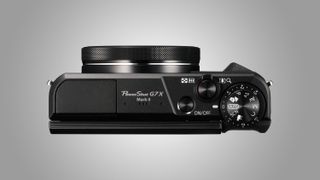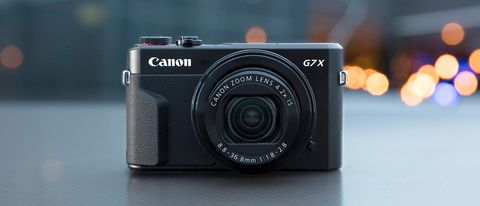Why you can trust TechRadar
Build and handling
- Solid metal construction
- Control ring
- Weighs 319g
Not too much has changed when it comes to the build and design of the G7 X II. It's one of the smaller G-series cameras, and will just about fit in a loose jeans pocket. While it's not as sleek as the PowerShot G9 X, there are compensations: the G7 X II's tilting screen and longer focal length range.
However, being small the G7 X II does lose out on a built-in viewfinder, something the larger PowerShot G5 X incorporates. And both the Sony RX100 V and the Panasonic Lumix ZS100 / TZ100 have found ways to include a viewfinder, so it's a little disappointing not to have one here, especially given that this is a camera designed to appeal as a backup to your DSLR.
That said, the tilting screen is great. It's bright, it's not unduly prone to reflections and it boasts a high resolution. It also tilts, so you can angle it out of direct sunlight if you need to, as well as framing shots from up high or down low, or flipping it for self-portraits. Although it's not fully articulating, the ability to tilt the screen downwards is an improvement over the original G7 X, and is helpful in some situations.

There are relatively few buttons and dials on the G7X II, and those that are present are all grouped together to make it easier to use the camera one-handed. On the top of the camera is a mode dial, which sits atop another dial that gives you quick access to setting exposure compensation.
The mode dial features manual and semi-automatic options, as well full auto, hybrid auto, scene and video modes. One option that's missing from the previous iteration of the camera is 'creative shot' – perhaps Canon felt this wasn't being used by the average enthusiast and decided to ditch it.
Around the G7 X II's lens is a dial that you can assign to adjust one of a number of settings – the obvious choice would be aperture. The dial clicks as confirmation that it's been moved, but there's a switch under the lens to turn the click off if you're trying to be discreet – another new feature.

Of the buttons on the back of the camera, a particularly useful one is marked with a Q. This brings up a quick menu on the rear screen which gives you access to a host of commonly used settings, such as file quality, ISO, white balance, metering and so on, saving you from having to delve into the main menu.
There's also a virtual version of this button on the touchscreen, which you tap to access the same menu. This quick menu, along with the main menu, can be navigated either by touch or by using the physical buttons. To set the autofocus point you tap the desired area on the screen.
Autofocus
- 31-point AF
- Face Detection
- Useful AF-Assist beam
Most of the time the G7 X II focuses very quickly on the subject, particularly in good light. It can take a touch longer in lower light, but it's fairly rare for a false confirmation to occur. Where the G7 X II does struggle, though, is with focusing closely on fine or small subjects, even with macro focusing enabled; if you like to take macro shots of insects, flowers and so on this isn't really the camera for you.
Current page: Build, handling and AF
Prev Page Introduction and key features Next Page Performance and image qualityAmy has been writing about cameras, photography and associated tech since 2009. Amy was once part of the photography testing team for Future Publishing working across TechRadar, Digital Camera, PhotoPlus, N Photo and Photography Week. For her photography, she has won awards and has been exhibited. She often partakes in unusual projects - including one intense year where she used a different camera every single day. Amy is currently the Features Editor at Amateur Photographer magazine, and in her increasingly little spare time works across a number of high-profile publications including Wired, Stuff, Digital Camera World, Expert Reviews, and just a little off-tangent, PetsRadar.


